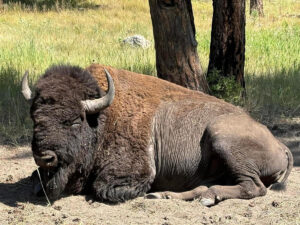 (…second in a series)
(…second in a series)
The big bull buffalo lay smack-dab in the middle of Cold Brook Mountain Trail in Wind Cave National Park. My companions and I had been warned about him by a hiker coming toward us. “I detoured way up into the woods to avoid him,” she said. “I’d turn back if I were you.”
Turn back? Was she giving advice straight out of “The Wizard of Oz”? Wild critters we don’t encounter east of the Mississippi River were one of the main reasons we’d planned this trip to South Dakota. We’d already seen hundreds of buffalo (“Tatanka,” as the Native tribes call them) on the Wildlife Loop in Custer State Park. Some were lounging close enough to the road that we stopped the car, rolled down the windows and took pictures.
But being on foot on a sparsely traveled trail up close and personal with a one-ton horned-and-hooved animal was a whole different thing. I was the only one who carried a “weapon”—a wooden hiking stick I use because my left hip hurts a lot these days. I’m pretty sure even Hank Aaron couldn’t have swung that stick hard enough to faze a buffalo. I certainly couldn’t.
But on we went anyway. We rounded a corner and there he was. Ahead of us, behind us and to our right was wide-open prairie. To our left was a steep wooded hill. How much leeway did we need to give this big guy? How likely was he to challenge us? Should we try to sneak past him or should we make lots of noise so as not to startle him? Or should we simply turn and dash back to the car, each of us hoping we weren’t the slowest runner in the group?
We chose none of those options.
Chatting quietly but fearlessly, we made our way uphill into the piney woods but noted right away an abundance of buffalo chips. Clearly, this beast could pursue us anywhere he wanted. The ground was thick with poison ivy, which a sign at the trailhead had warned about. It had also warned of ticks and mosquitoes and flies and rattlesnakes. Yep, rattlesnakes. Just how much did four beyond-middle-age women out for a nature stroll have to prove? Not this much, we decided. So we hightailed it back to the trail and retraced our steps, with me tucking my stick beneath my arm rather than leaning on it like a crutch. Thankfully, the buffalo didn’t follow.
We made it to the car safe and sound and drove to the visitor center. In the restroom, we stripped off shoes and socks and rolled up our britches and scrubbed our legs and feet with hot soapy water. Then we learned a whole lot about symbiosis in wild South Dakota by watching the Wind Cave movie and visiting the museum.
Herds of buffalo fertilize the prairie with their manure, making it a perfect place for prairie dogs to build underground towns. In turn, prairie dogs fertilize and aerate the soil, which makes grasses lush and nutritious for buffalo and other grazing species such as elk, deer, pronghorn, mountain goats, bighorn sheep and wild burros.
Coyotes and black-footed ferrets, one of North America’s most endangered species, work together to dine on prairie dogs. Ferrets burrow into the holes and run the little rodents out into the open, where coyotes catch, kill and oftentimes share them with other predators. Although most predators feast on a variety of prey, ferrets eat prairie dogs almost exclusively. Without them, the ferrets die off en masse. That’s why a healthy prairie dog town is so ecologically vital. Another thing we learned about prairie dogs is that, though they’re a terrible choice for a pet for a million different reasons, they’ve become popular for just such a purpose in Japan. Go figure.
Coming next week: Faces in stone. I can hardly wait to write that one.
(September 14, 2024)